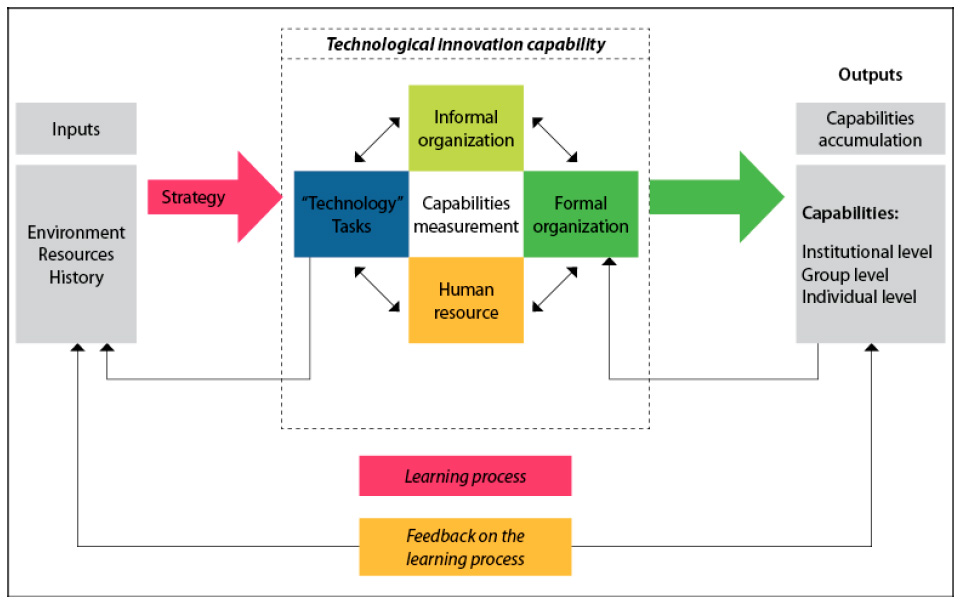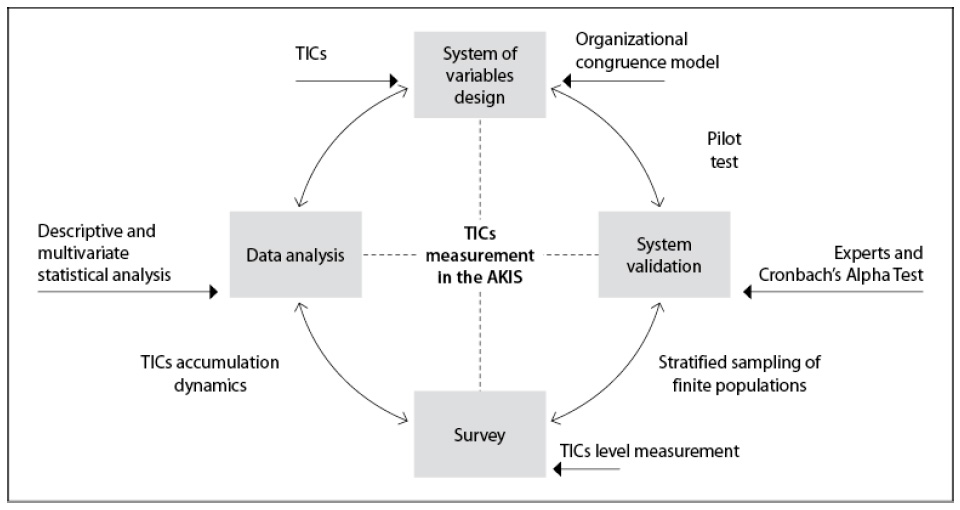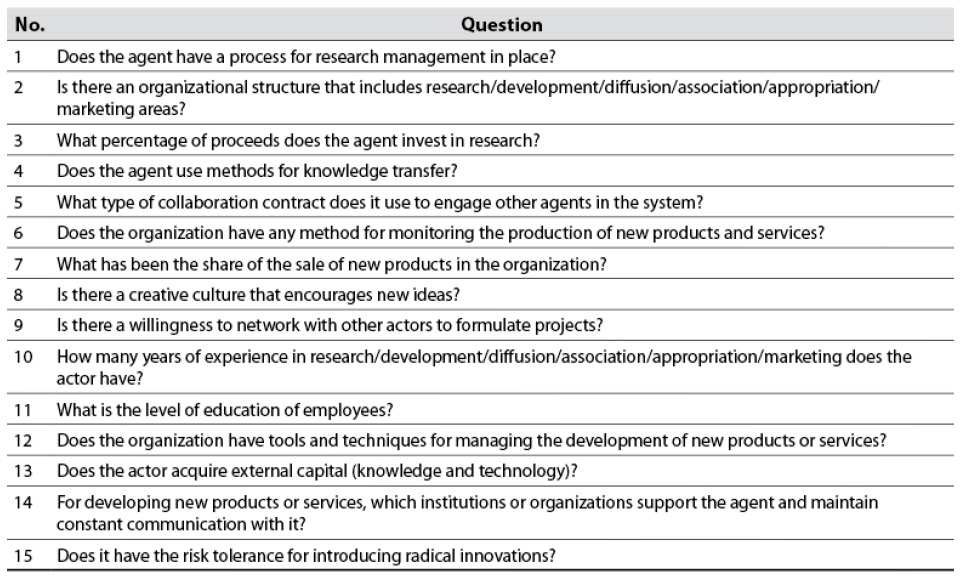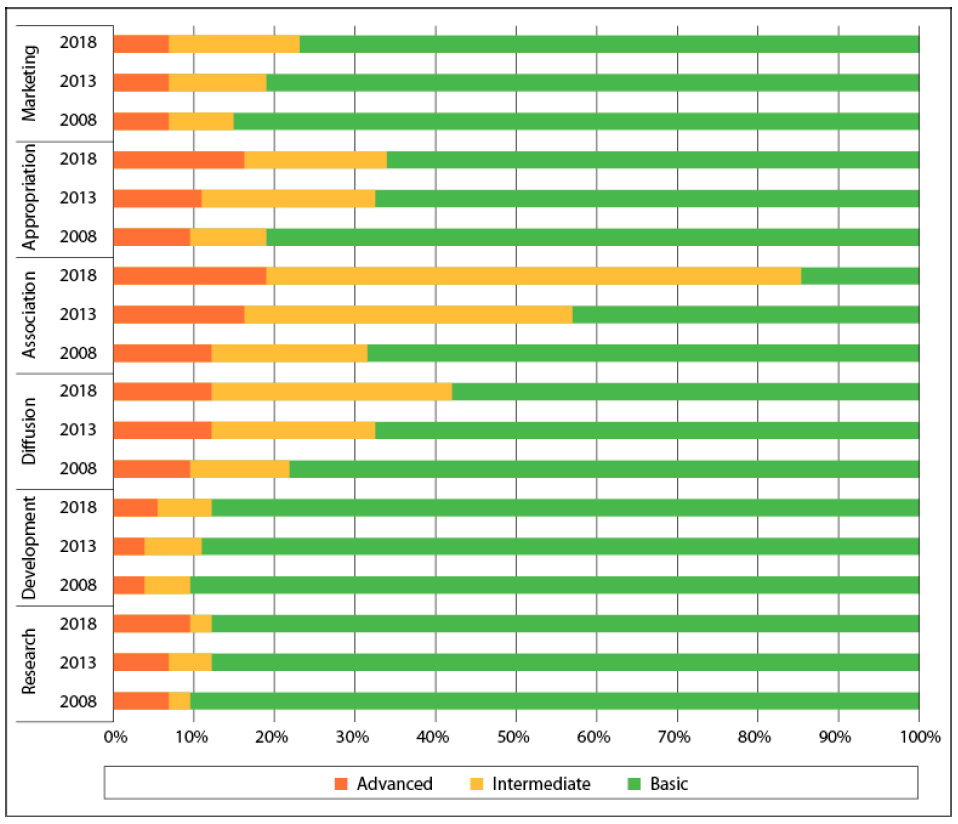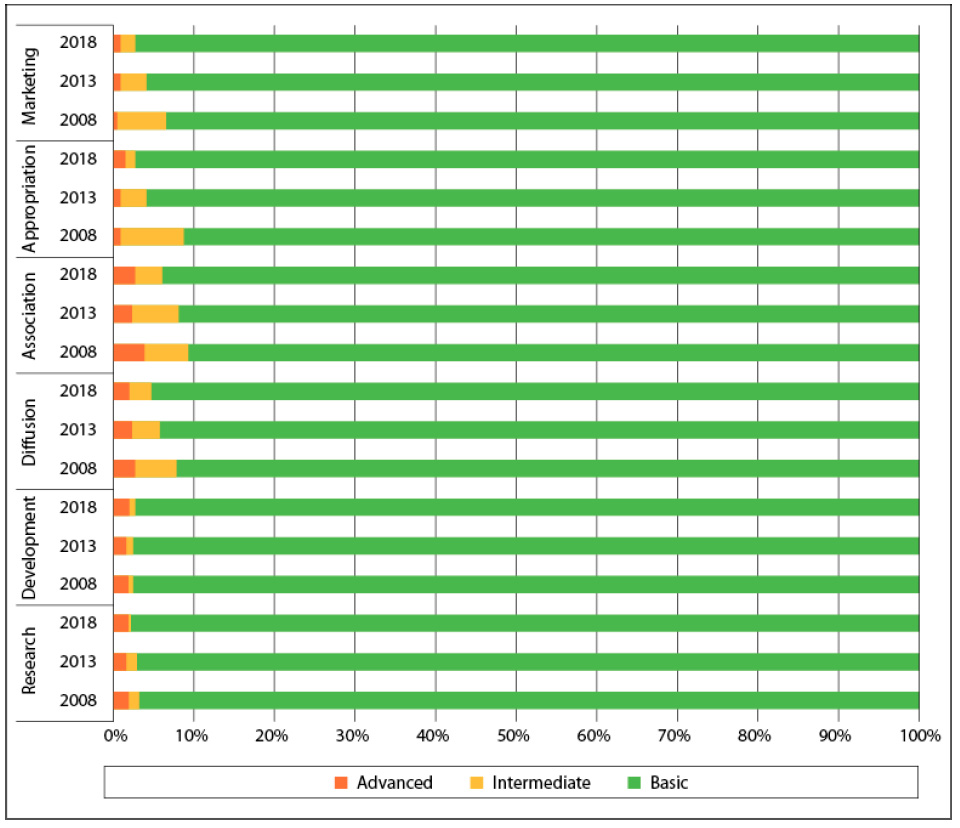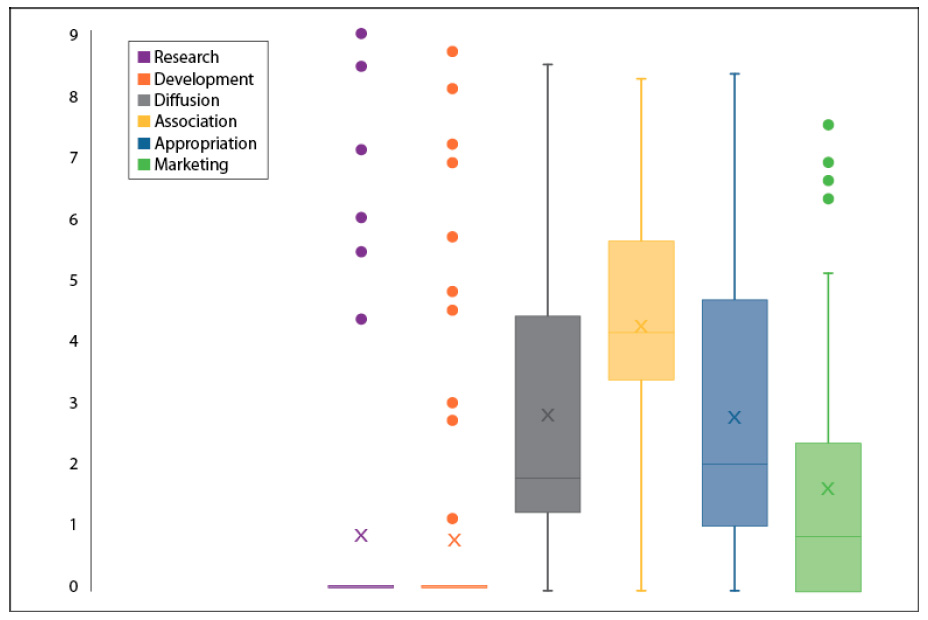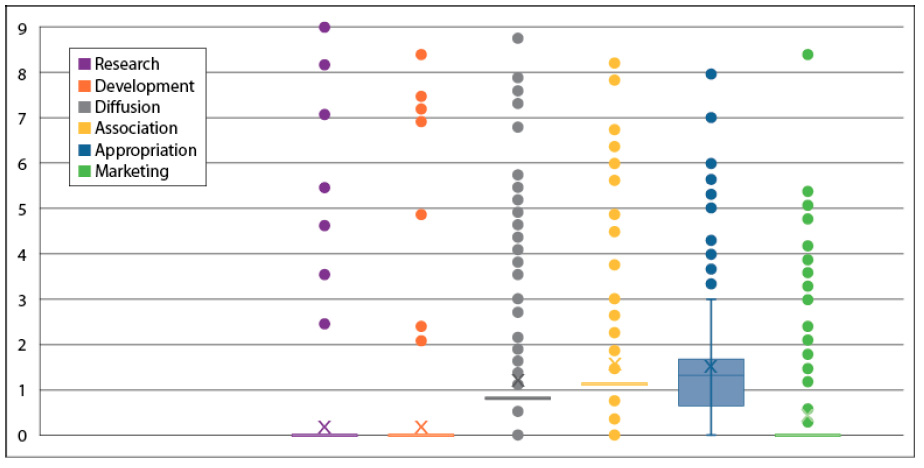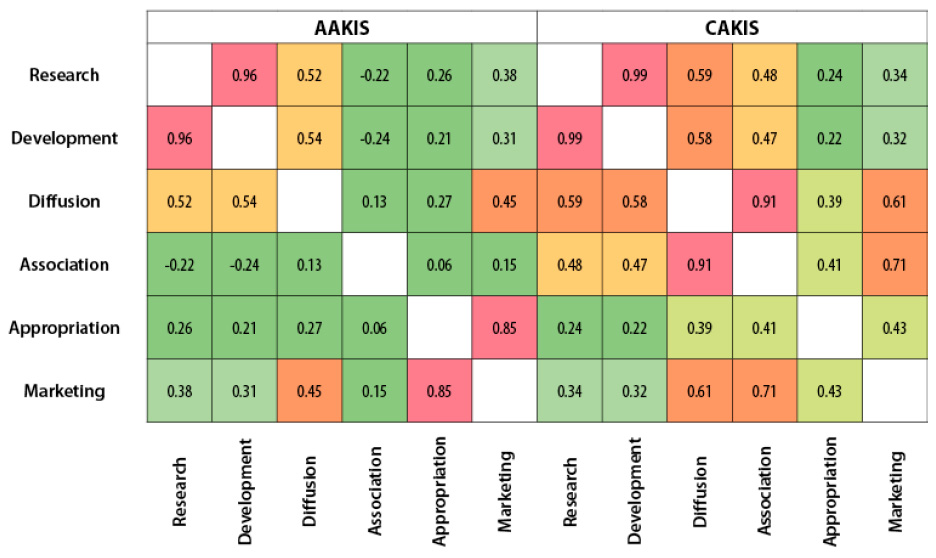Introduction
According to specialized literature, agricultural production chains (APCs) are related entities that create value as a competitive advantage source (Hernández & Pedersen, 2017). They are characterized by networking among companies with distinctive features, creating new knowledge essential to facing changing environments. According to these characteristics, APCs behave as an agricultural knowledge and innovation system (AKIS), defined as a set of organizations with links and interactions among them that are engaged in the generation, transformation, transmission, integration, diffusion, and use of knowledge for problem-solving and innovation (Islam, 2010; Röling & Engel, 1990). AKISs play a fundamental role in agriculture; they have high economic and social potential by creating new knowledge and markets (Pietrobelli & Rabellotti, 2011).
Due to their organizational and systemic nature, AKISs can be approached by innovation systems (Edquist, 1997) made up of a network of public and private institutions whose activities and interactions promote innovation and interactive learning through their knowledge generation, diffusion, and use functions. This network fosters the system’s evolution by accumulating capabilities (Quintero et al., 2017; Quintero & Giraldo, 2018) to meet the competitive environment’s needs and improve innovative performance (Freeman, 1987). Capabilities are the agent’s abilities to make use of resources in carrying out some activity (Hafeez et al., 2002); therefore, they allow characterizing and differentiating the firms in any system and knowing their roles, relationships, and learning patterns to establish policies and strategies that improve their performance.
AKISs are recognized for discovering and disseminating new knowledge and technologies that improve agricultural production, requiring increasing organization integration to face changing competitive environments (Boyaci & Yildiz, 2017). For this, their knowledge and technology generation, diffusion, and use functions must be strengthened by accumulating technological innovation capabilities (TICs) arising from interactive learning processes influencing their performance (Ruiz et al., 2016).
The enabling functions of innovation systems are essential to identifying the roles and relationships of companies (Carlsson et al., 2002) and define the patterns of capability accumulation resulting from the interaction among related agents in exploration, production (Gilsing & Nooteboom, 2006), and intermediation (Klerkx & Leeuwis, 2009) cycles. Capabilities are an organization’s fundamental characteristics that facilitate and support its technological innovation strategies (Guan & Ma, 2003; Yam et al., 2004); furthermore, they are considered crucial for an organization to consolidate innovation (Serrano et al., 2017) and achieve strategic competitiveness (Conner, 1991; Penrose, 1959). These TICs are associated with the innovation system’s enabling functions. Research and development capabilities are related to the knowledge and technology generation function, diffusion and association capabilities to the knowledge and technology diffusion function, and appropriation capabilities for innovation production and marketing to the knowledge and technology use function.
From this perspective, the most innovative companies are characterized by highly effective collective learning systems (Doloreux & Parto, 2005; Tushman & Nadler, 1986), enabling capability accumulation. A capability involves an organization’s knowledge, experience, and skills (Richardson, 1972), essential to building a competitive advantage (Baden-Fuller, 1995) through innovation management, which is carried out through corporate guidelines and individuals (Nadler & Tushman, 1980).
Organizations are effective if their components are structured and managed consistently by applying coherent strategies according to the environment in which they compete. Also, there must be congruence among the parts comprising them and the activities necessary to implement the strategy. Based on Nadler and Tushman’s (1997) contingency theory of companies, adequate innovation management requires a constant search for the congruence of the parts comprising it to design and form a competitive firm.
Accordingly, TIC measurement should be conceived as an organizational system that enables fulfilling an organization’s innovation objectives. It would imply that, for each capability, it is necessary to build a congruent organization in all its dimensions; for example, for measuring research capability, it will be necessary to analyze its four elements: formal (ƒ), informal (i), technological (t), and human (h) (figure 1).
Understanding the elements that create competitive advantages in sectoral localized innovation systems (Chang & Chen, 2004), such as some AKISs, is closely related to the innovation functions associated with TICs and requires analysis from a comprehensive perspective. This analysis is necessary to comprehend and identify the phenomena that hinder innovation and the gaps that prevent the internalization of structural and systemic changes, resulting in low adoption of technologies (Kuijpers & Swinnen, 2016). Some authors point out that existing measurement methods impede understanding the dynamic and systemic nature of capabilities. Given the lack of variable integration, they do not consider company characteristics such as size and geographic location, but characterize the types of firms from a linear and static approach, just like in the organizational innovation literature (Camisón & Villar-López, 2014; Robledo et al., 2010; Sher & Yang, 2005; Wang et al., 2008; Yam et al., 2004). TIC measurement in AKISs will help diagnose the current status of TICs and the existing technological gaps in the system, highlighting the difficulties in local networking, transferring knowledge between farmers and other agents in the system (Labarthe & Moumouni, 2008; Nagel & Von der Heiden, 2004; Nieuwenhuis, 2002), exploring external knowledge, and combining skills and routines (Gielen et al., 2003; Klerkx et al., 2012).
Then, this study intends to measure the TICs of avocado and coffee AKISs. A stratified sample of 254 organizations in the Coffee Agricultural Knowledge and Innovation System (CAKIS) and 74 organizations in the Avocado Agricultural Knowledge and Innovation System (AAKIS) was taken in Antioquia, Colombia. A system of variables that associates TICs with Nadler and Tushman’s (1980, 1997) organizational behavior model was employed.
The study hypotheses were a) associating TICs with the dimensions of an organizational behavior model will facilitate the development of a system of variables to measure TICs levels related to the innovation functions of AKIS firms; b) measuring the TICs level and its dynamic variations over time facilitates the understanding of AKIS innovation processes by identifying the existing gaps between TIC levels and the enabling functions (knowledge and technology generation, diffusion, and use) of an innovation system, and c) there is a strong correlation between the enabling functions (knowledge and technology generation, diffusion, and use) of AAKIS and CAKIS.
Materials and methods
The method used to measure TICs in the AKISs studied comprised four stages (figure 2). In the first stage, the system of variables was built to identify the most relevant information on the TICs of the firms that make up the AAKIS and CAKIS, based on the relationship between TICs and the dimensions of Nadler and Tushman’s model (1997). A Likert scale was used to quantify each TIC (Robledo et al., 2010; Wang et al., 2008; Yam et al., 2004). According to Lall’s categories (1992, 2001), capabilities were classified into advanced, intermediate, and basic.
In the second stage, the system of variables and the metric used were validated by Cronbach’s alpha test, together with expert validation, to examine the proposal’s conceptual, theoretical, and procedural soundness and the feasibility of obtaining successful results.
The third stage was to collect data to measure the TIC level in the AAKIS and CAKIS analyzed. For this, an instrument was created, and a search of primary sources was carried out through interviews with the most representative AKIS firms. Secondary sources of structured information in specialized scientific databases were also used to identify the relationships between the agents that make up each system. The system of variables was then applied through semi-structured surveys of the firms that make up the CAKIS and AAKIS, defined by a stratified sampling of finite populations. Subsequently, TICs levels were quantitatively analyzed. The sample was determined based on the agents that make up the avocado and coffee agricultural production chain links and the public and private institutions related to the systems.
Finally, in the fourth stage, the descriptive and multivariate statistical analysis of the collected data was performed. The multivariate analysis was carried out using the Pearson correlation coefficient, a measure of the strength of the linear relationship between the variables evaluated. Statistical analyses made it possible to identify the characteristics of the firms that make up the AKISs under study based on TIC evolution and accumulation in the observed periods. Likewise, it was possible to determine which TICs have exhibited insufficient accumulation or decumulation.
Results and discussion
As a result, a system of variables was designed to measure TICs in the CAKIS and AAKIS. Changes in TIC accumulation or decumulation in 2008, 2013, and 2018 were analyzed from this system.
System of variables design
A system of variables that associated TICs to the organizational behavior model was designed to estimate the TICs of the firms that make up the AAKIS and CAKIS in Antioquia. An important implication of the congruence hypothesis is that, for diagnosing organizational problems, it is necessary to describe the system, identify the problems, and determine the causes to arrange key components and obtain the best congruence in the organization (Nadler & Tushman, 1980).
From this perspective, firms with the capability of marketing innovations, for example, will have to develop a joint strategy with their technological systems (tasks/technology), human resources (personnel), and formal and informal organizations to market their new products or services and achieve the firm’s innovation objectives. This reasoning was used for each TIC measured in the AKISs studied.
The system of variables was fed with the most representative characteristics of the firms (size, location, networking, among others) to classify and characterize them according to their generation, diffusion, or use functions. Subsequently, each TIC was evaluated from the organizational dimensions. The system had 59 variables distributed in the following dimensions: 22 questions in formal organizations, 13 in informal organizations, 13 in human resources, and 11 in technology. The survey (table 1) and data collection were carried out at three specific moments (2008, 2013, and 2018) using a Likert scale.
The variables and dimensions were then related to each capability to quantify their average value and estimate their level through parameterization. The levels were established between 0 and 9, according to Lall’s proposal (1992); for example, advanced TICs have a numerical value between 6-9, intermediate TICs between 3-6, and basic TICs between 0-3. Table 2 contains an example of some system variables for measuring TICs and their relationship with organizational components.
Table 2 Relationship between functions, TICs, and organizational components
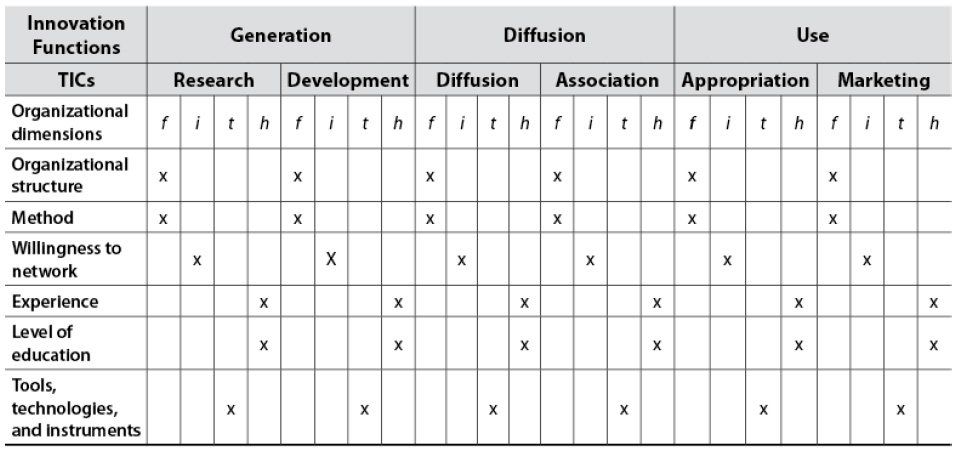
Note.ƒ: formal organization dimension; i: informal organization dimension; t: technology dimension; h: human resource dimension.
Source: Elaborated by the authors
Each of the research, development, diffusion, association, appropriation, and marketing capabilities was identified, and the evolution of each TIC of the studied firms was determined to reveal the dynamics and structure of the evaluated systems. The data collected was compared with general information from the AKISs. Cronbach’s alpha test yielded a calculated value of 0.8, concluding that the system of variables is reliable and that the measurement scale is acceptable. Thus, the measurement of TICs related to the innovation functions of the agents in the AKISs is facilitated by a system of variables that associates TICs with the dimensions of an organizational behavior model.
TICs level measurement in AKISs
In the AAKIS, the system of variables was applied to 74 firms, with a 95 % confidence interval and a 10.8 % calculated margin of error. For the CAKIS, the system was applied to 256 firms, with a 95 % confidence interval and a 6.7 % calculated margin of error. The first findings indicate that, in the AAKIS firms, 73 % of the TICs are basic, 17 % intermediate, and 10 % advanced (figure 3). In addition, TICs had the following percentage variations in the evaluated period: research (-6.8 %), development (-5.80 %), diffusion (-1.9 %), association (5.6 %), appropriation (0.4 %), and marketing (-4.3 %).
In the CAKIS firms, the TICs are basic and show unrepresentative increases in the evaluated periods (figure 4). The percentage increase of each TIC was research (0.4 %), development (0 %), diffusion (2.0 %), association (3.0 %), appropriation (5.9 %), and marketing (2.7 %).
Descriptive and multivariate analysis of TICs
The descriptive analysis results for each TIC in the AAKIS and CAKIS are summarized in table 3.
Table 3 Summary of the statistical analysis of TICs in the AAKIS and CAKIS
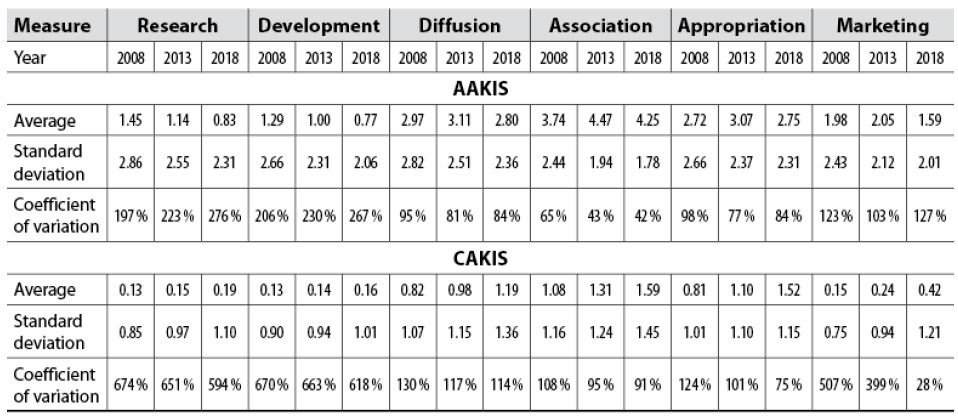
Note.none of the standardized bias and standardized kurtosis values were between -2 and +2, concluding that the sample data did not come from a normal distribution.
Source: Elaborated by the authors using Statgraphics Centurion XVI
A high coefficient of variation was observed (table 3), reflecting a significant dispersion in the data. It was necessary to display the information in box plots (figures 5 and 6) to illustrate the point cloud behavior and detect outliers. The figures show several outliers for each TIC, representing the AKIS firms with much more advanced capabilities than the data set.
The samples did not show a normal distribution behavior in the descriptive analysis; so, it was necessary to transform the data to reduce the asymmetry among them and perform the multivariate multiple correlation analyses. Multivariate analysis with Pearson correlation coefficient measures the strength of the linear relationship between variables. The Pearson correlation coefficient for each TIC in the AAKIS and CAKIS is shown in table 4.
It was noted that the AAKIS has several strong linear relationships between the research-development and appropriation-marketing variables. On the contrary, in the CAKIS, there are several strong linear relationships between the research-development and diffusion-association variables (table 4). Besides, there are several medium linear relationships between diffusion-research, development-diffusion, marketing-diffusion, and marketing-association. However, this correlation is not strong enough to accurately conclude that the variables are linearly dependent on each other. Several weak linear relationships do not allow a correlation between the enabling functions of the AKISs.
Results analysis
The results show that the TICs in the AAKIS are basic compared to the average data, which do not exceed the value of this level (3), except for the association capability (intermediate level). The changes in association and marketing capabilities between 2008 and 2013 allow us to infer that the chain accumulated such capabilities due to the demand of international markets, promoting the construction of new complex and integrated knowledge bases to use this knowledge strategically.
Regarding the CAKIS in Antioquia, the system comprises many firms, more than 79,000, of which around 97 % are small growers. This characteristic determines the high percentage of agents with basic capabilities. It should be highlighted that in both AKISs, several firms (outliers)—mainly with intermediate and advanced capabilities—seek to carry out innovation processes through interaction with other links that can impact overall performance.
A fundamental characteristic of the AKISs studied is the importance of exporting products with high- quality standards for process profitability. In recent years, the AAKIS has had excellent potential for export to international markets, demonstrated by an increased marketing capability in 2013. Nevertheless, the accumulation of this capability has recently decreased. One possible cause of this detriment is the problem with the appropriation capability for production. The increase in areas planted with avocado in the last four years (49 %) (Ministerio de Agricultura y Desarrollo Rural, 2018), associated with the increased interest in this crop, shows a significant growth of new firms with basic appropriation TICs for production.
In the CAKIS, one of the most striking characteristics was the increase in most capabilities in the evaluated period, except for research and development capabilities. This change is attributed to the implemented policies that broaden mainly intermediation and exploitation capabilities in the smaller CAKIS firms since, with the help of various institutions, knowledge of a differentiated market opportunity (specialty coffees) was disseminated.
However, it is noteworthy that 82 % of the firms that made up the sample do not market their products since coffee growers do not have direct contact with customers and consumers, and an institution and several private trading companies are in charge of the export processes. In 2016, private companies exported 61 % of Colombian coffee, while the National Federation of Colombian Coffee Growers (FNC, for its acronym in Spanish) exported 39 % (Ministerio de Comercio, Industria y Turismo, n.d.). Its primary destination is the large multinational coffee companies (Rincón et al., 2016), which carry out the bean processing.
Based on the multivariate analysis, some gaps were identified in the interactions among AKIS firms that hinder technological learning processes and the improvement of productivity and competitiveness. When analyzing the correlation of capabilities using Pearson’s coefficient (figure 7) concerning the functions of an innovation system established by Carlsson et al. (2002) and Edquist (1997), it can be affirmed that the AAKIS has a strong correlation between research and development capabilities in the generation function, and between appropriation and marketing capabilities in the use function. However, no correlation in the diffusion function was noted, given the low linear relationship between association and diffusion capabilities. As this is one of the most significant barriers to crop modernization, a deficiency derives from knowledge exchange and learning processes that allow TIC generation and accumulation (Quintero, Marín, et al., 2019).
The preceding shows the limitations and weaknesses of technological appropriation in production, logistics, and market processes, which reflect in a fruit that does not meet external markets’ quality standards due to peduncle rot, agrochemical residues, low cosmetic quality, and mechanical damages of the fruit that affect pulp quality (Quintero, Ruiz, et al., 2019).
For its part, in the CAKIS, there is a strong correlation between research and development capabilities in the generation function and between diffusion and association capabilities in the diffusion function. Nonetheless, there was no correlation in the use function, which constitutes the most significant gap in the system structure due to the low correlation between appropriation and marketing capabilities. This finding shows the little participation of growers in technology adoption for developing new products and processes. One possible cause of this limitation could be a technical barrier (Mojaveri et al., 2011) in appropriators whose staff have difficulties introducing technologies created by external sources.
The low correlation between the generation function and the appropriation capability could be due to an insufficient capacity to translate innovation and development into coffee growing processes. This relationship could also be hindered by a lack of methods to scale innovation and development products (Mazurkiewicz & Poteralska, 2017).
The gaps between the functions of the AAKIS and CAKIS can be classified as economic and organizational barriers, which, according to Mazurkiewicz and Poteralska (2017), are existing asymmetries between supplier and recipient in different characteristics (skills, prices, equipment, internal structure, size, and experience) and insufficient knowledge of potential markets and consumers.
Conclusions
Measuring the TIC level associated with the organizational components described by Nadler and Tushman (1980, 1997) in the AKISs helped identify the capability accumulation dynamics and analyze the gaps between TICs and the enabling functions of the evaluated systems. The accumulation and decumulation dynamics of TICs in the AKISs are systemic, active, and emerging, making it difficult to formulate effective policies to improve the performance of AKISs since modeling and simulation are required to observe their behavior closely.
The AAKIS’s TICs are classified as primary, except for the association capability, which strongly correlates with the generation and use functions. However, there is no correlation in the diffusion function due to the low linear relationship between association and diffusion capabilities, one of the most significant barriers to technology adoption and transfer.
Moreover, over 90 % of CAKIS firms have basic capabilities, making technology adoption and transfer challenging since they do not adequately meet the competitive environment’s needs. It was observed that 82 % of the organizations that make up the sample do not market their products. The basic appropriation capability was the most representative gap in CAKIS innovation processes as it impedes the structuring of the use function, limiting the efficient interactions between firms and different functions in the system.











 text in
text in 


